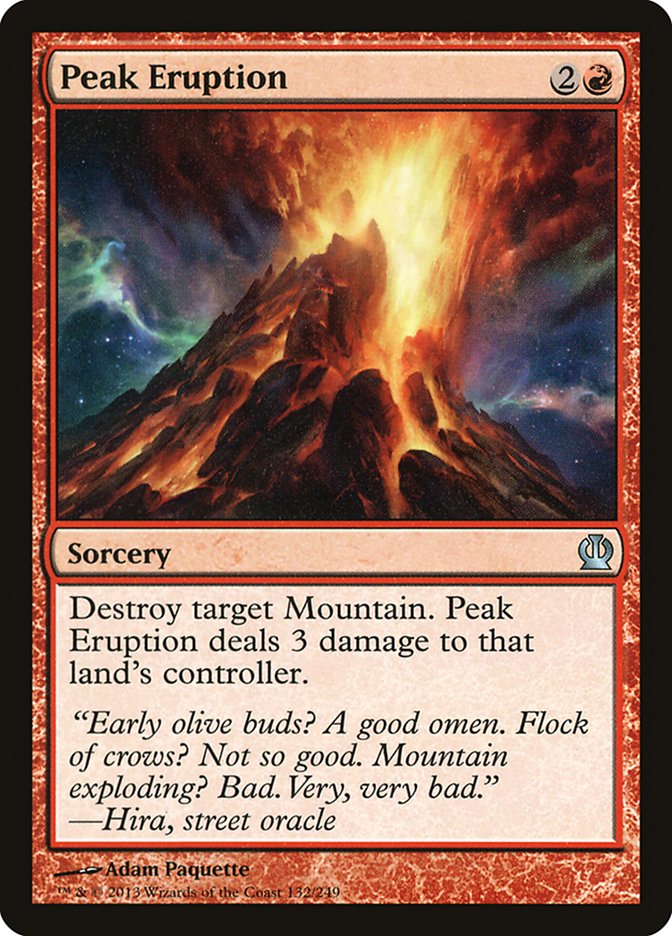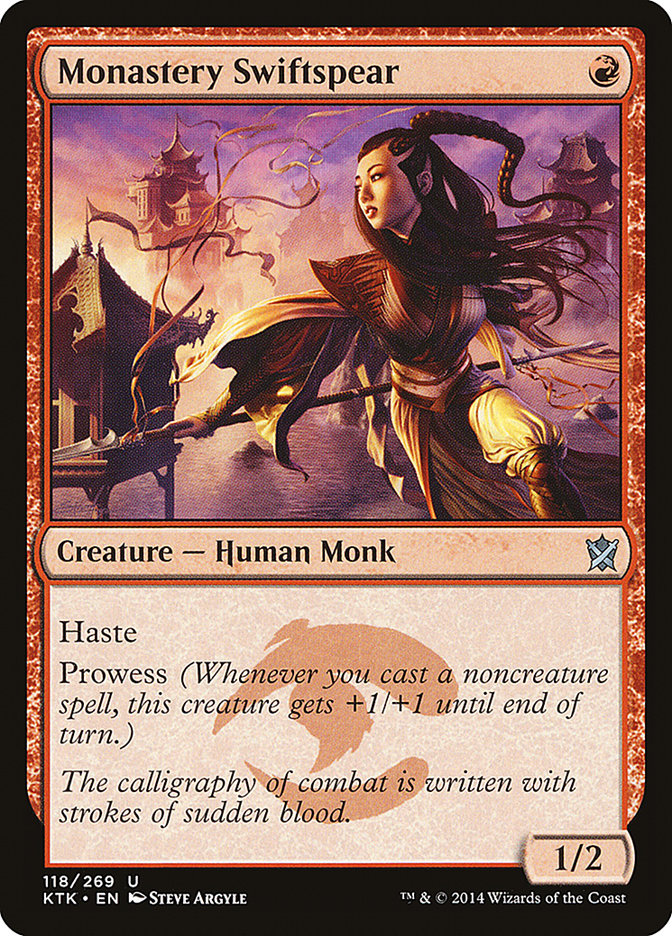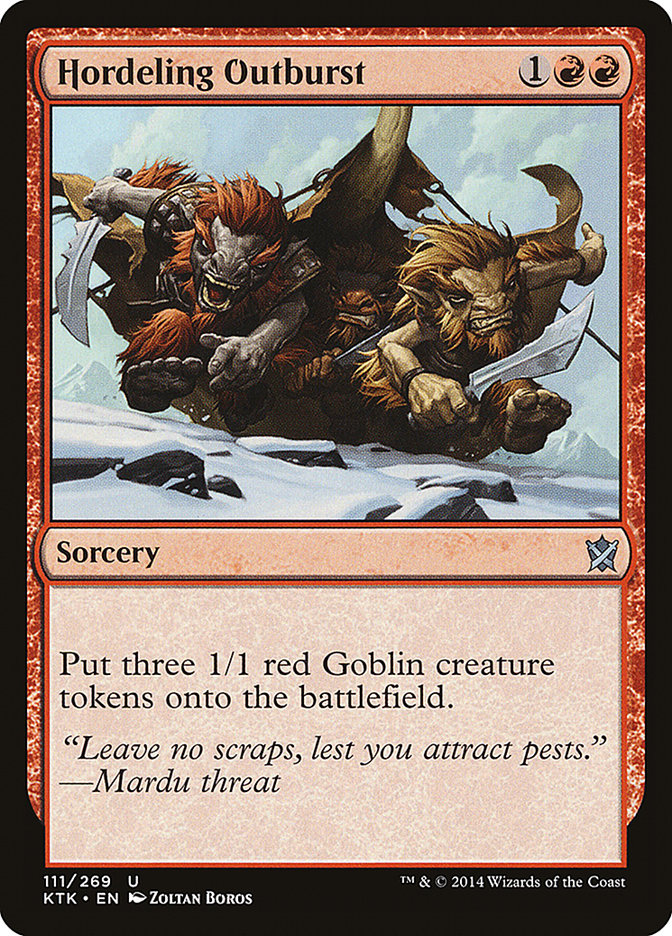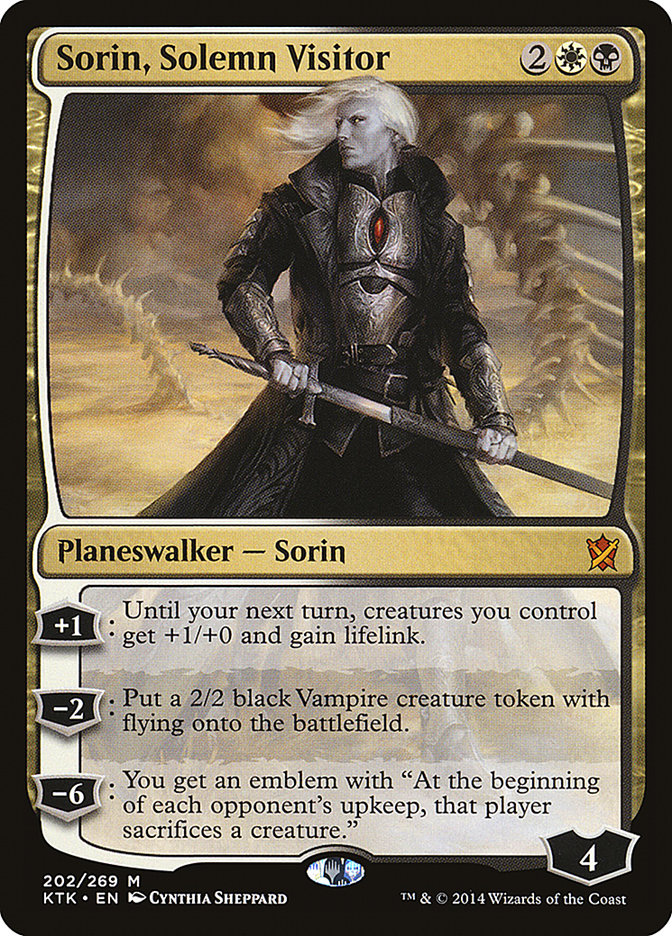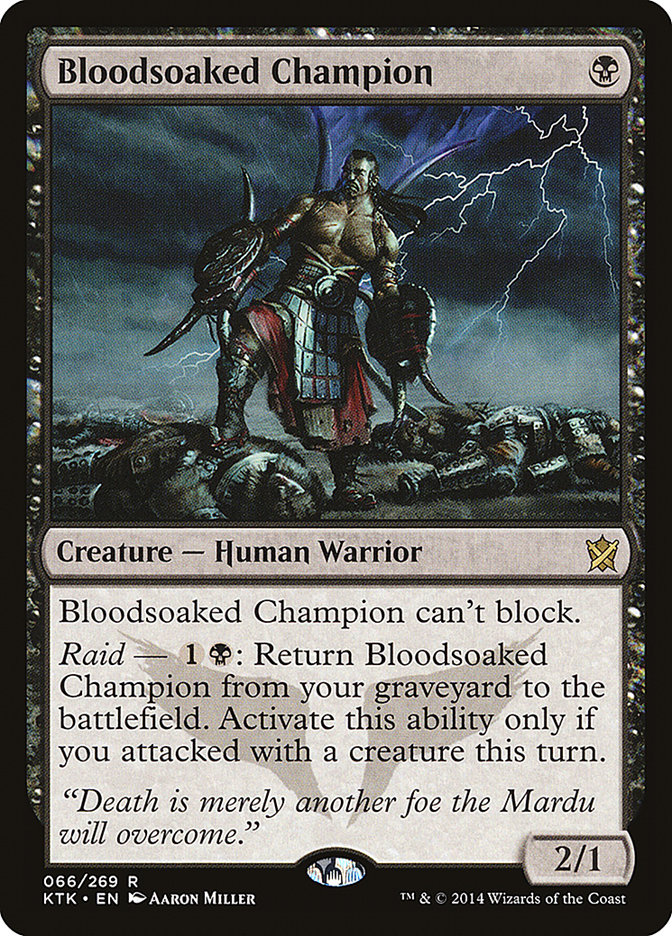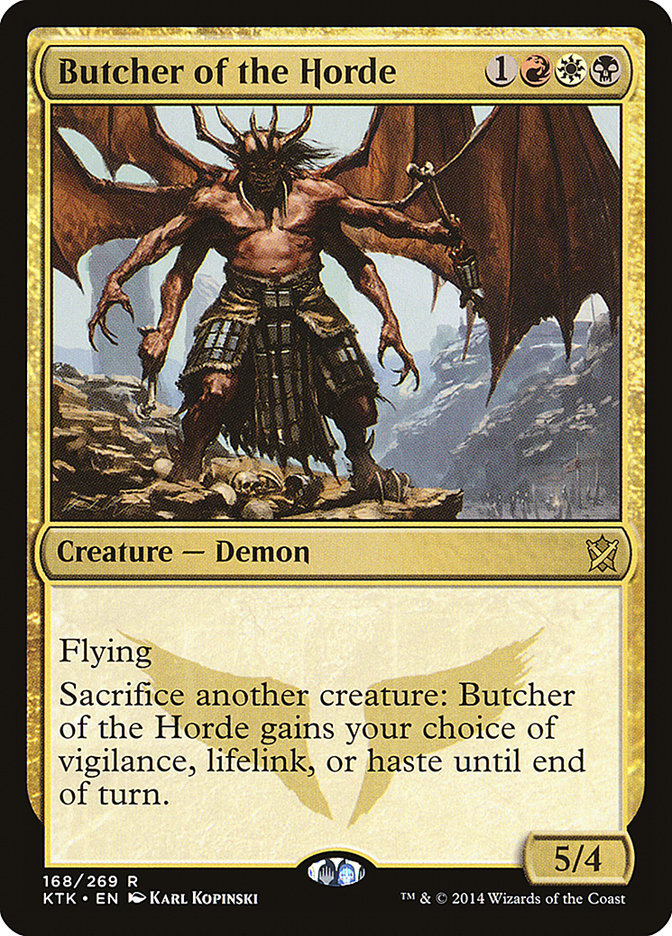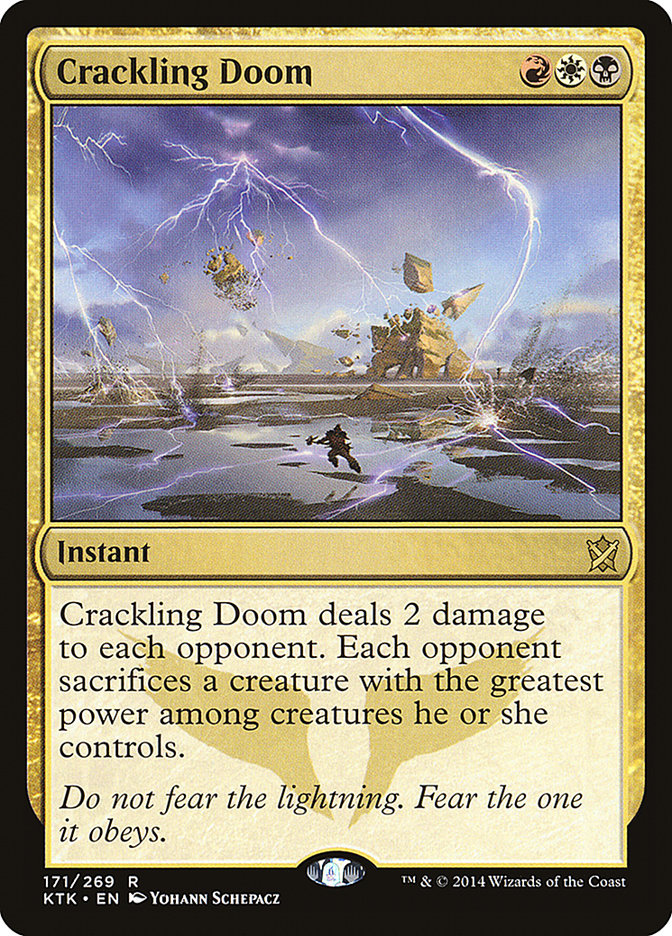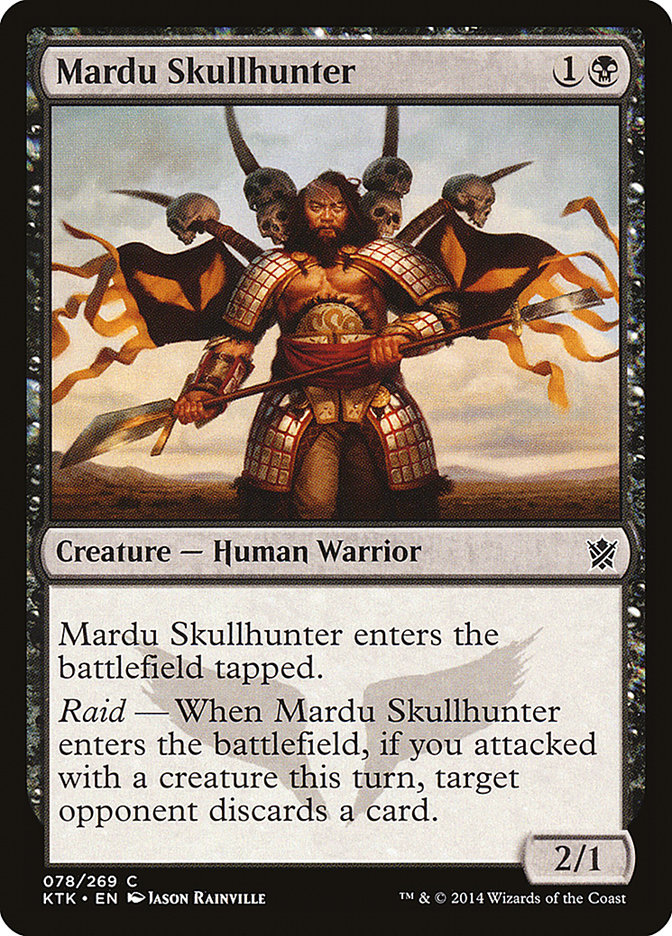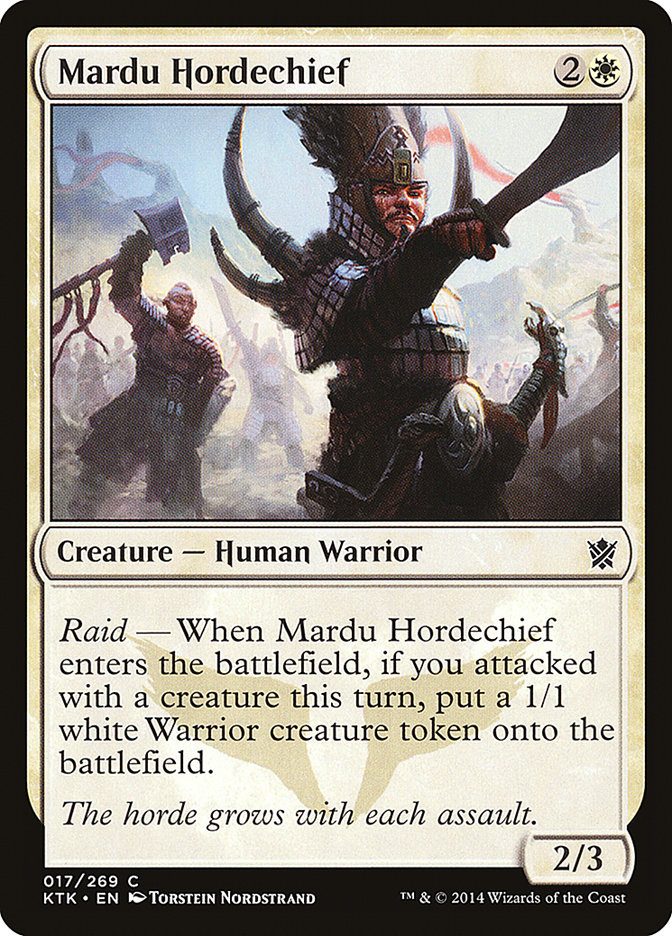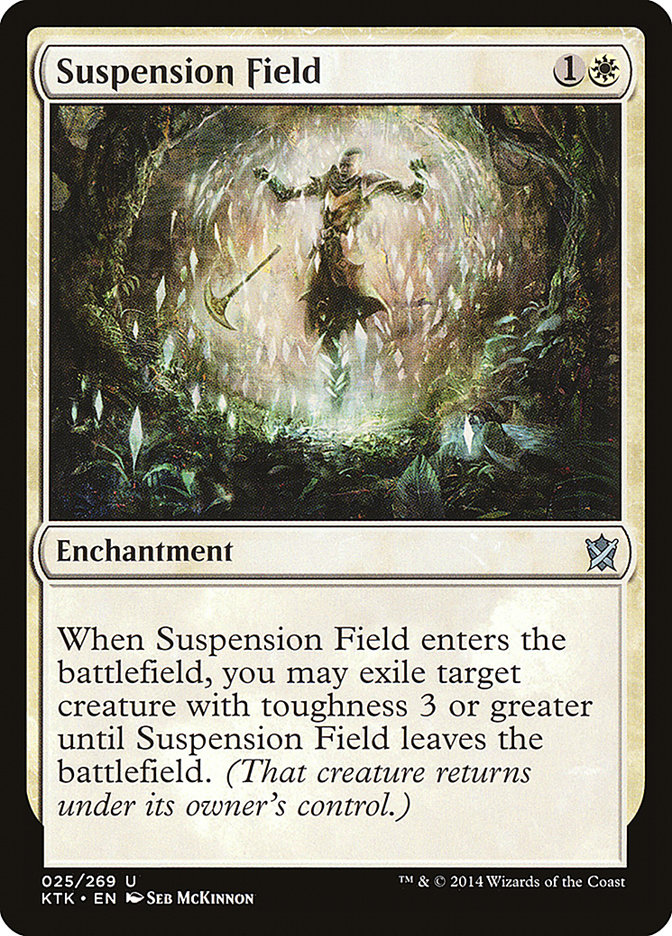Khans of Tarkir is sick.
The most hotly anticipated set in recent memory is finally here, along with the most hotly anticipated rotation in recent memory. Khans appears to have a
design philosophy that meshes nicely with Theros block, bringing with it a different texture than the Standard formats we’ve been used to. No four-mana
sweepers. Plenty of reason to play three-colors, without pushing five color. Lots of great midrange cards but also some options for aggro and control. No
degenerate blue cards.
Today, I’d like to focus on aggressive decks. Courser of Kruphix is shaping up to be a defining card of the format, which makes sense since it was the best
card in Block and fetchlands have shot its power into god tier. Any aggressive decks that are going to cut it in this new world have to be informed by the
existence of so many different Courser of Kruphix decks. To get an idea of some of the decks I expect to see in the format to come, check out midrange
decks here. Friday, I’ll be back with a look and
combo and control decks.
Let’s start with most obvious pillar of aggro, Goblin Rabblemaster. After all, if there’s an aggro card that can go toe-to-toe with Courser of Kruphix,
it’s Goblin Rabblemaster. Goblin Rabblemaster is sort of like a Brimaz that creates a 1/1 token the first turn, rather than needing to wait. It is easier
to beat in combat, but Red is great at clearing a path. On top of all of this, it’s easier to cast and hits much harder (albeit without vigilance).
The most obvious place to try Goblin Rabblemaster first is Mono-Red Aggro:
Creatures (22)
- 4 Frenzied Goblin
- 2 Foundry Street Denizen
- 2 Stormbreath Dragon
- 4 Firedrinker Satyr
- 2 Eidolon of the Great Revel
- 4 Goblin Rabblemaster
- 4 Jeering Instigator
Planeswalkers (3)
Lands (24)
- 24 Mountain
Spells (11)

There are a lot of possible ways to go with mono-red, so let me just touch on some of what I’m seeing, and maybe you can go a better way than this initial
sketch. First of all, there is reason to go all creatures, thanks to Foundry Street Denizen. Of course, there is also a reason to go as few creatures as
possible, thanks to Monastery Swiftspear. To make it even more challenging, the natural ideal mix is generally closer to the middle (potentially harming
both of those cards).
The two-slot on red’s curve isn’t embarrassing, but it’s not great. Eidolon of the Great Revel is such a suspect two-drop on the draw, and in fact, I’d
often look to sideboard it out when I won the previous game. It gets so much better on the play, however, I’d board in the other two almost every time.
Speaking of sideboarding, Peak Eruption is a sideboard card that is likely to improve in the new format. Fetchlands replace shocklands when it comes to
putting actual Mountains in play; but more importantly, red decks are more often going to rely on five-drops. Goblin Rabblemaster means more people are
playing red, and the powerful Mardu and Jeskai cards are making Chained to the Rocks look better than ever.
Jeering Instigator is a funny sort of two-drop, since we really want to play it as a three-drop. Of course, doing so misses a Foundry Street Denizen
trigger, but the prospect of getting a free Act of Treason is super appealing in this new world of Siege Rhinos and Polukranos.
Chandra, Pyromaster looks great in the new format. It helps get Goblin Rabblemaster through. The card draw helps us hit that important fifth mana to cast
our five-drops, despite just 24 land. It also helps pick off the many great one-drops, which I expect there to be more of than usual.
In fact, I think one of the important points of the new format is figuring out how to take advantage of just how many of the best creatures have either
one, four, or five toughness. One practical consequence of this is that Stoke the Flames is the best mono-red burn spell, while Lightning Strike is
somewhat questionably positioned. I’m not even sure that fourth Lightning Strike shouldn’t be another Arc Lightning. After all, Arc Lightning can hit two
one-drops at the same time, potentially gaining a lot of edge against aggro. In fact, I’m not even sure Lightning Strike belongs at all. Besides Fleecemane
Lion, what does Lightning Strike do that Magma Jet doesn’t do even better?
Stormbreath Dragon and Sarkhan, the Dragonspeaker are great cards, but why play so many lands? Why not just play less lands and more smaller threats?
Recall all the midrange cards in halls this fall will stall brawls, then maul you all, if you try to claw through the wall with all small ball. Stormbreath
and Sarkhan give us some much needed finishing power.
If you want to go low, I guess you can try to update Heroic Red, but the deck’s slightly underpowered, really missing Madcap Skills.
Creatures (25)
- 4 Frenzied Goblin
- 4 Foundry Street Denizen
- 4 Akroan Crusader
- 4 Firedrinker Satyr
- 1 Satyr Hoplite
- 4 Goblin Rabblemaster
- 4 Jeering Instigator
Lands (19)
- 19 Mountain
Spells (16)

Not really too many surprises here, though it is worth noting that Jeering Instigator has a lot of potential to turn around games that get stalled out
against green decks.
I think if I played a Heroic deck, the first place I’d look is to update Stanislav Cifka’s Boros Heroic deck from Block:
Creatures (20)
Lands (20)
Spells (20)

The biggest problem with Cifka’s deck was the manabase was not what I would consider “playable.” Battlefield Forge is exactly what the doctor ordered.
Additionally, Defiant Strike gives us another cantrip Heroic enabler, helping us cycle through the deck quickly. Hammerhand helps dodge Siege Rhinos, as
well as giving our Rabblemaster haste. Finally, Goblin Rabblemaster is just a nice power-level upgrade, which works great with Phalanx Leader.
This list actually looks very promising. The ability to sideboard (or even maindeck) Suspension Field, Stoke the Flames, and Magma Spray give us some
fantastic removal options. It’d be awesome if we could play Chained to the Rocks, but I just don’t see where we’d get the Mountains, particularly if we
want to hold on to Phalanx Leader.
Alternatively, we might decide that Chained to the Rocks and all of the other quality Boros cards that stand on their own are more appealing, instead of
relying on synergy. The mana curve starts getting a little suspect if you just play the most powerful cards, but maybe you end up looking something like:
Creatures (19)
- 2 Stormbreath Dragon
- 4 Soldier of the Pantheon
- 4 Firedrinker Satyr
- 3 Brimaz, King of Oreskos
- 4 Goblin Rabblemaster
- 2 Monastery Swiftspear
Planeswalkers (4)
Lands (24)
Spells (13)

The good news: This Boros list’s card quality is higher than most.
The bad news: So, how’s that second turn looking..?
Monastery Swiftspear is a somewhat speculative addition, but with seventeen ways to trigger it, several at instant speed, I thought I’d give it a shot.
Besides, at the end of the day, it’s still a Raging Goblin with upside. Still, this list is kind of set up to play a little more of a mid-speed game, and
as such, might end up just wanting to cut them for more Chandra/Arc Lightning action.
When looking at Boros decks, one of the questions we have to ask ourselves is why aren’t we playing black? Obviously, the effect on our manabase is not
trivial, but there are a lot of appealing Mardu and B/W gold cards in Khans of Tarkir. One of the things I love about Khans of Tarkir is how many of the
good cards suggest different deckbuilding paths, rather than all stacking in the same direction.
For instance, one possible approach to Mardu is a token-based strategy:
Creatures (15)
Planeswalkers (3)
Lands (25)
Spells (17)

Raise the Alarm, Hordeling Outburst, Mardu Charm, Goblin Rabblemaster, Brimaz, King of Oreskos, and Sorin, Solemn Visitor add up to a lot of good
token-making. Dictate of Heliod, Spear of Heliod, and Sorin, Solemn Visitor are all excellent ways to pump our team. We even gain a little defense against
End Hostilities, thanks to Mardu Charm. Butcher of the Horde is also a token “reward,” of sorts. It’s usually going to be worth trading a token in for five
extra damage, thanks to haste, and lifelink will ensure you are a favorite to win races.
Bloodsoaked Champion sort of functions like a token maker, being a delayed Doomed Traveler that hits harder. Besides, we’re pretty desperate for one and
two-mana plays, and Bloodsoaked Champion is a pretty powerful Magic card in its own right. Bring it back one time and you are pretty ahead of the game.
Instant speed token makers like Raise the Alarm and Mardu Charm make it easier to turn the Champion on, and Goblin Rabblemaster and Butcher of the Horde
effectively have haste. Butcher of the Horde, in particular, works very well with Bloodsoaked Champion, letting you use his abilities every turn without
losing material.
Going a pretty different direction, we could build around Warriors instead of tokens. This means using Obelisk of Urd, Raiders’ Spoils, Chief of the Scale,
and Chief of the Edge for pumps.
Creatures (24)
- 4 Tormented Hero
- 4 Goblin Rabblemaster
- 4 Butcher of the Horde
- 4 Chief of the Scale
- 4 Chief of the Edge
- 4 Bloodsoaked Champion
Lands (23)
Spells (13)

Every creature in this list is a Warrior, with the exception of Butcher of the Horde (who doesn’t need the help) and the Rabblemaster tokens. That means we
can actually play a pretty mean “token” game, while all of our creatures individually hit hard. Remember, the tokens from Mardu Charm are Warriors too.
Mardu Charm and Crackling Doom give us a lot of removal, and Raiders’ Spoils does an amusing Bident of Thassa impression, at times. The Necro-ing ability
is optional, but even if you get low, Butcher of the Horde can fill you back up.
Chief of the Edge obviously hits really hard, but Chief of the Scale isn’t too shabby, itself. Goblin Rabblemaster gaining a third point of toughness can
be pretty clutch against Courser of Kruphix.
Crackling Doom is one of my favorite cards in Khans of Tarkir. It is usually going to kill the creature you want, plus gives you extra damage. This is
particularly important when facing problematic threats like Siege Rhino, which are hard to burn and hard to race. That Crackling Doom also hits Sylvan
Caryatid and Sagu Mauler is just icing on the cake.
Of course, none of these Warrior Crusades are actually red, so if we’re willing to give up unbelievable creatures like Goblin Rabblemaster and Butcher of
the Horde and great removal like Crackling Doom and Mardu Charm, we can streamline our mana.
Creatures (27)
- 4 Tormented Hero
- 3 Soldier of the Pantheon
- 4 Mardu Skullhunter
- 4 Chief of the Scale
- 4 Chief of the Edge
- 4 Bloodsoaked Champion
- 4 Mardu Hordechief
Lands (23)
Spells (10)
Sideboard

Once again, all of the creatures are Warriors, with the exception of the Soldiers of the Pantheon. I had considered Mardu Hateblade and Herald of Anafenza,
which makes Warrior tokens, but wanted to stick to more individual card quality, rather than rely on Warrior synergies. I also considered just playing less
one-drops, but if we’re going to make Mardu Skullhunter work, we really need them.
Mardu Hordechief is no Goblin Rabblemaster, but at least it’s three power worth of Warriors that gets double pumped from your Crusades. Even when you fail
and have to just take the 2/3, it’s not the end of the world.
One of the nice advantages of W/B, in this list, or any other, is how many awesome sideboard cards they have access to. There’s a lot of specialized
removal in the format, and once you know what you’re up against, you can solve a lot of problems for less mana than usual. You also have access to
sweepers, discard, and other niche effects.
Of course, in our quest to streamline our mana, we can go even further, and strip out the white too. Mono-Black Aggro was a popular strategy in Block, and
it gains another fantastic one-drop and better removal.
Creatures (29)
- 4 Tormented Hero
- 2 Agent of the Fates
- 3 Mogis's Marauder
- 4 Pain Seer
- 4 Herald of Torment
- 4 Spiteful Returned
- 4 Gnarled Scarhide
- 4 Bloodsoaked Champion
Lands (22)
Spells (9)
Sideboard

Bloodsoaked Champion is exactly what Mono-Black Aggro was looking for, a one-drop that hits hard and keeps hitting as the game goes on. There’s lots of
sweet tactical tricks you can do, like put Spiteful Returned on it to keep the pressure on, then get the Bloodsoaked Champion back, despite having
suicidally attacked with it. Herald of Torment and Mogis’s Marauder are also great ways to get it back as the game goes on.
Murderous Cut is a speculative addition that would get better if we maindecked more Thoughtseizes or Sign in Blood. The fetchlands do make it come online
faster, and the prospect of getting to make two big plays on turn 4 is very appealing. Still, we do have to keep an eye on the life loss from the
fetchlands.
One possibility is to splash white for Sorin, Solemn Visitor. Playing Temple of Silence does slow us down a bit, but Sorin is a pretty powerful card. I’m
hesitant to go down the Mana Confluence path, as we are already so bad at blocking.
Creatures (29)
- 4 Tormented Hero
- 2 Agent of the Fates
- 3 Mogis's Marauder
- 4 Pain Seer
- 4 Herald of Torment
- 4 Spiteful Returned
- 4 Gnarled Scarhide
- 4 Bloodsoaked Champion
Planeswalkers (3)
Lands (22)
Spells (6)
Sideboard

Yet another possibility is to go mono-white, instead of mono-black. There’s several directions you could go with mono-white, but most of them seem like
they’d be better if you just added black and/or red. One path that might actually have some incentive to stay mono-white is that of Soldiers-tribal.
Obelisk of Urd is a powerful card, and if we can actually get enough Soldiers to fuel it while having our mana be perfect, that is pretty exciting.
Creatures (19)
- 4 Phalanx Leader
- 4 Favored Hoplite
- 4 Soldier of the Pantheon
- 1 Hero of Iroas
- 4 Brimaz, King of Oreskos
- 2 Herald of Anafenza
Lands (21)
- 21 Plains
Spells (20)

Hrmm. That’s a pretty tight squeeze, as twelve heroic enablers isn’t a ton. I mean we don’t need to power up our heroic creatures, but it’d be
nice. Nyxborn Shieldmate is another Solider that could potentially replace Herald of Anafenza if we decided we wanted a few more ways to pump our
creatures.
We could also trade in the soldier theme for green cards to push the heroic component in a way that did not have the mana to support it in Block:
Creatures (20)
Lands (22)
Spells (18)

Windswept Heath is a crucial addition to this strategy, enabling the mana for Warrior’s Lesson, Setessan Tactics, and Reap What is Sown for tons of
multi-targeting action. Defiant Strike is also just an excellent heroic enabler for any Phalanx Leader deck that wasn’t available in Block.
The thing is, I’m just not sure the green cards are exciting enough to replace the red cards we could be using. The red cards are so much cheaper.
I guess the green cards do hit a little harder, so maybe there’s some value in the ability to brawl, but I am skeptical.
G/W, as a color combination, is not exactly calling out to be played. There are no two-color allied gold cards for it, and the best new green and white
cards are all gold. I mean, what would G/W even look like? If we try to build around Courser and Elspeth, our deck is a bit of a schizophrenic mess. For
instance:
Creatures (26)
- 4 Elvish Mystic
- 4 Polukranos, World Eater
- 4 Sylvan Caryatid
- 2 Arbor Colossus
- 4 Fleecemane Lion
- 3 Brimaz, King of Oreskos
- 4 Courser of Kruphix
- 1 Soul of Theros
Planeswalkers (6)
Lands (24)
Spells (4)

Literally only Windswept Heath wasn’t already available, and it’s definitely worse than Temple Garden. The only G/W decks that were succeeding in the old
format were much faster, using a lot of cards that rotated out. Trying to force one of those fast G/W Aggro decks doesn’t inspire a lot of confidence:
Creatures (28)
- 4 Polukranos, World Eater
- 4 Fleecemane Lion
- 4 Boon Satyr
- 4 Soldier of the Pantheon
- 4 Brimaz, King of Oreskos
- 4 Spirit of the Labyrinth
- 4 Sunblade Elf
Planeswalkers (1)
Lands (24)
Spells (7)

Spirit of the Labyrinth might be randomly sweet against Read the Bones and Sign in Blood, but I am not exactly in love with it. Suspension Field is kind of
sweet, and while looking a bit like a sideboard card on the surface, maybe it can get some maindeck play for decks that just really appreciate removal
without having access to nice things, like black mana.
At the end of the day, though there is probably just no good reason to play G/W, when you could play Abzan. Siege Rhino is too strong, and Black has so
many good aggro creatures if you’re aggressive, and removal/discard if you’re controlling. We talked about Abzan midrange decks on Monday, so here’s a look
at a much more aggressive build:
Creatures (28)
- 4 Fleecemane Lion
- 4 Tormented Hero
- 1 Herald of Torment
- 4 Gnarled Scarhide
- 3 Anafenza, the Foremost
- 4 Rakshasa Deathdealer
- 4 Siege Rhino
- 4 Bloodsoaked Champion
Lands (24)
Spells (8)

I’m pretty excited about this line of exploration. Siege Rhino is an absolutely messed up Magic card, and there is no reason that only midrange decks
should benefit from it. This build plays sort of like a slightly bigger Mono-Black Aggro, but wow does it get some power level boosts.
Fleecemane Lion and Rakshasa Deathdealer are both extremely aggressive two-drops that give us a lot to do with our mana later in the game. They are also
both very resilient and particularly good targets with +1/+1 counters from Anafenza or Abzan Charm.
Anafenza, the Foremost is perfect for this deck, as you’ll almost always have another target, making it sort of a 5/5 Whirling Dervish. It fits so
perfectly in this deck, I’m not even sure we want the one Herald of Torment at all. Maybe we really can just play four Anafenzas.
One three-color combination we haven’t really touched on yet, is Jeskai. Talk about a tricky Khan to work with! There are some really great removal spells,
really great planeswalkers, and some really great midrange creatures, but they don’t exactly fit together naturally. This is a pretty loose use of the term
aggro deck, but here’s a first crack at Jeskai Tempo:
Creatures (14)
Planeswalkers (3)
Lands (25)
Spells (18)

The threats are top notch, including a virtual metric ton of haste. The burn helps buy us some time, then stacks well with the haste creatures. Siege Rhino
is a serious problem for this deck, and even Chained to the Rocks is very risky. If they Banishing Light or Utter End your Chains on their Rhino, you are
going to be one sad panda.
The two cards I am really interested in here are Mantis Rider and Jeskai Charm. Mantis Rider is exactly the kind of creature a red deck would love, and
there are so few three-toughness creatures now, we might get a lot of value out of people playing Drown in Sorrow instead of Bile Blight and Magma Jet
instead of Lightning Strike.
Jeskai Charm is a deceptively strong card. Dealing four damage is the perfect backside to a solid creature removal spell like Repel. These two modes alone
would be enough to entice me, but the +1/+1 and lifelink ability is game-winning a lot of the time. It’s just so back-breaking in races. It even has me
wanting to consider a token-making sub-theme, possibly alongside Jeskai Ascendancy.
The last aggro deck I’d like to take a look at today is an oldie, but a goodie. This strategy was a defining force of the past year, but fell flat in Block
without enough support. Could Khans of Tarkir have enough blue permanents to bring Thassa back?
Creatures (26)
- 4 Thassa, God of the Sea
- 4 Omenspeaker
- 4 Master of Waves
- 4 Vaporkin
- 4 Hypnotic Siren
- 4 Triton Shorestalker
- 2 Paragon of Gathering Mists
Lands (24)
Spells (10)

Okay, yes, we did lose a lot. Like a whole lot. Like every single card in the deck, besides Thassa, Master, and Bident. The good news is those
cards are pretty strong, and the format is going to be completely switching the direction of its hate to fight green midrange and red aggro decks. Fliers
could be well-positioned.
The biggest problem with Mono-Blue Devotion is that we’ve lost almost every card that brought multiple devotion to the table. Mindreaver is just such an
awful card, but maybe we have to play it if we want to actually power up our devotion. I’d rather start with the fliers, however, since at least they combo
well with Bident and Paragon of Gathering Mists. Mindreaver is seriously just going to get outclassed by every single card in the format, so I’m not even
sure why we’re using it instead of cards like Dictate of Kruphix if all we want is devotion.
Disdainful Stroke is a bright spot on the landscape. It’s very efficient and the format is looking likely to contain lots of juicy targets. The Voyage’s
End + Disdainful Stroke combo is a great way to spend turn 4, and being able to play a two-drop while still holding up the Stroke to stop a Rhino is
definitely nice.
Overall, I don’t have the highest hopes for Mono-Blue Devotion. So far, testing has made it seem pretty hard to actually wake up Thassa, though Master of
Waves has still been good. Bident has actually been fantastic, particularly given just how much evasion we have. I wonder if we’re supposed to move towards
an even more skies-oriented direction?
Alright, I’m out for today, but I will be back with combo and control decks.
Because, let’s be serious.
Did anyone really believe Blue was dead?


